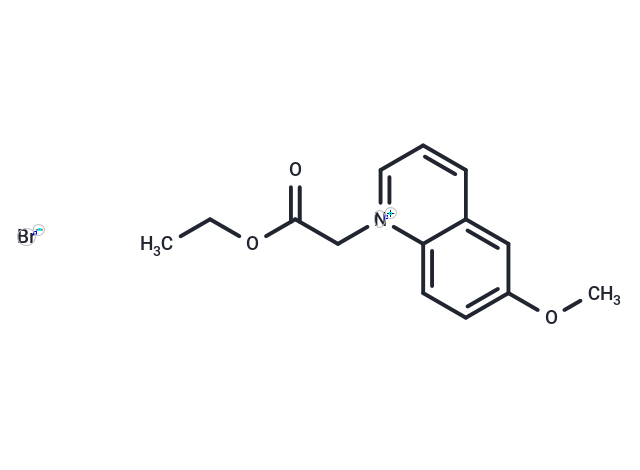Shopping Cart
Remove All Your shopping cart is currently empty
Your shopping cart is currently empty
MQAE, a fluorescent chloride ion indicator, is more sensitive and selective than 36Cl and microelectrode-based methods for chloride measurement in cells. MQAE is quenched via collision with chloride.

| Pack Size | Price | USA Warehouse | Global Warehouse | Quantity |
|---|---|---|---|---|
| 25 mg | $36 | In Stock | In Stock | |
| 50 mg | $51 | In Stock | In Stock | |
| 100 mg | $81 | In Stock | In Stock | |
| 200 mg | $129 | - | In Stock | |
| 1 mL x 10 mM (in DMSO) | $50 | In Stock | In Stock |
| Description | MQAE, a fluorescent chloride ion indicator, is more sensitive and selective than 36Cl and microelectrode-based methods for chloride measurement in cells. MQAE is quenched via collision with chloride. |
| In vitro | I. Chloride ion detection 1. Solution preparation: Dissolve MQAE in DMSO or aqueous solution. Make sure the concentration of the solution is suitable for cell experiments, generally 1-10 µM. 2. Staining: Add cell culture to medium containing MQAE and incubate for 30 minutes to 1 hour to allow the probe to penetrate into the cells. 3. Fluorescence detection: Use fluorescence microscopy or flow cytometer for detection, with an excitation wavelength of 350 nm and an emission wavelength of 460 nm to monitor the effect of chloride ion concentration on fluorescence intensity. II. pH stability Use MQAE to monitor chloride ion activity under different pH conditions to confirm that it remains stable under low chloride ion concentration conditions. III. Confocal microscopy and flow cytometer Use labeled cells for fluorescence microscopy or flow cytometer experiments. Use a 350 nm UV excitation source and monitor fluorescence emission at 460 nm to detect the effect of changes in chloride ion concentration on the intracellular environment. |
| Molecular Weight | 326.19 |
| Formula | C14H16BrNO3 |
| Cas No. | 162558-52-3 |
| Smiles | [Br-].CCOC(=O)C[n+]1cccc2cc(OC)ccc12 |
| Relative Density. | no data available |
| Color | Yellow |
| Appearance | Solid |
| Storage | store at low temperature,keep away from direct sunlight | Powder: -20°C for 3 years | In solvent: -80°C for 1 year | Shipping with blue ice/Shipping at ambient temperature. | |||||||||||||||||||||||||||||||||||
| Solubility Information | DMSO: 62.5 mg/mL (191.61 mM), Sonication is recommended. | |||||||||||||||||||||||||||||||||||
| In Vivo Formulation | 10% DMSO+90% Saline: 2.5 mg/mL (7.66 mM), Sonication is recommeded. Please add the solvents sequentially, clarifying the solution as much as possible before adding the next one. Dissolve by heating and/or sonication if necessary. Working solution is recommended to be prepared and used immediately. The formulation provided above is for reference purposes only. In vivo formulations may vary and should be modified based on specific experimental conditions. | |||||||||||||||||||||||||||||||||||
Solution Preparation Table | ||||||||||||||||||||||||||||||||||||
DMSO
| ||||||||||||||||||||||||||||||||||||
| Size | Quantity | Unit Price | Amount | Operation |
|---|

Copyright © 2015-2026 TargetMol Chemicals Inc. All Rights Reserved.